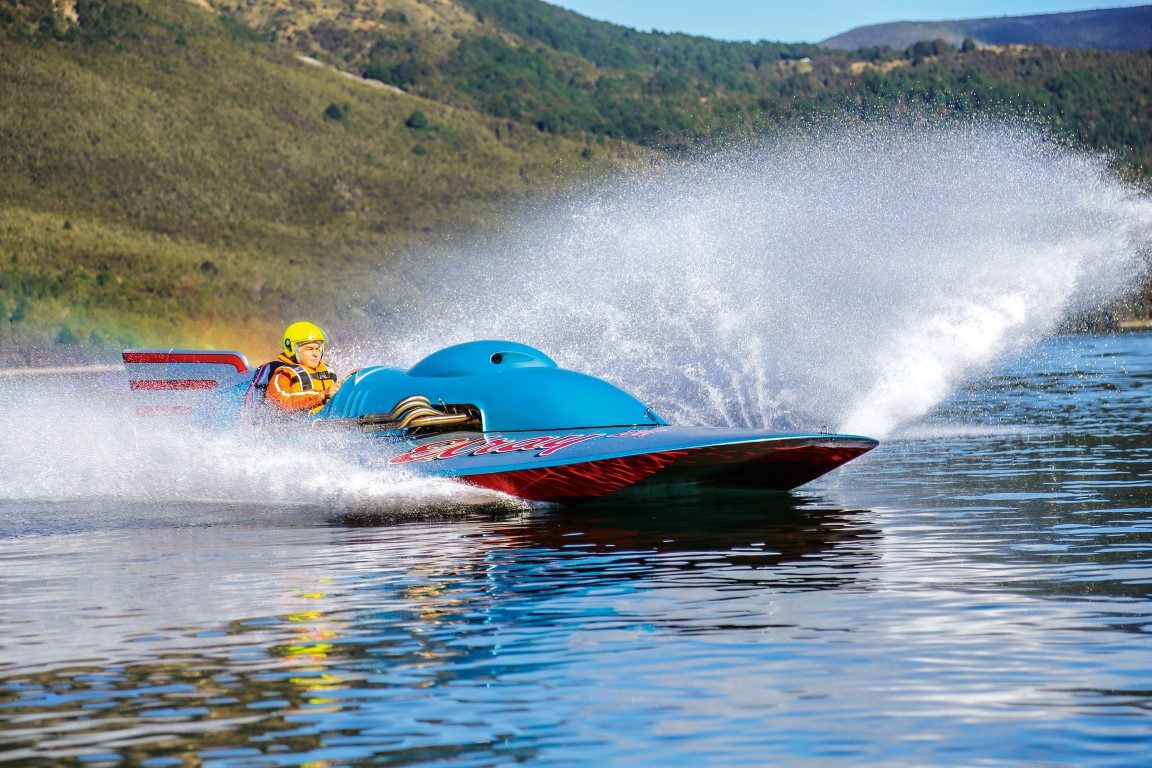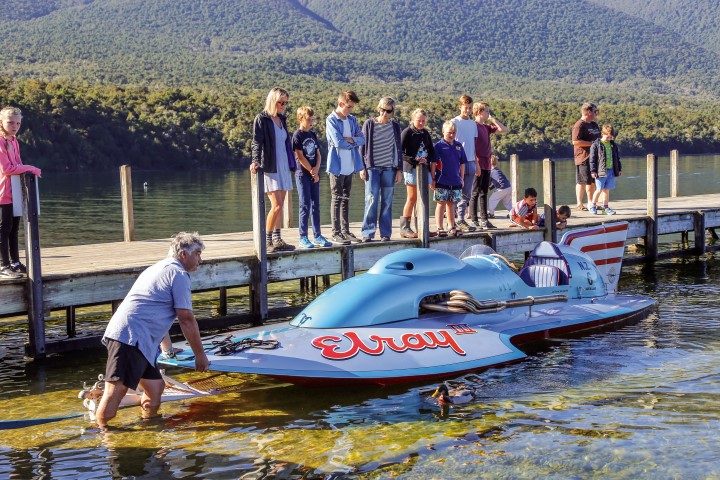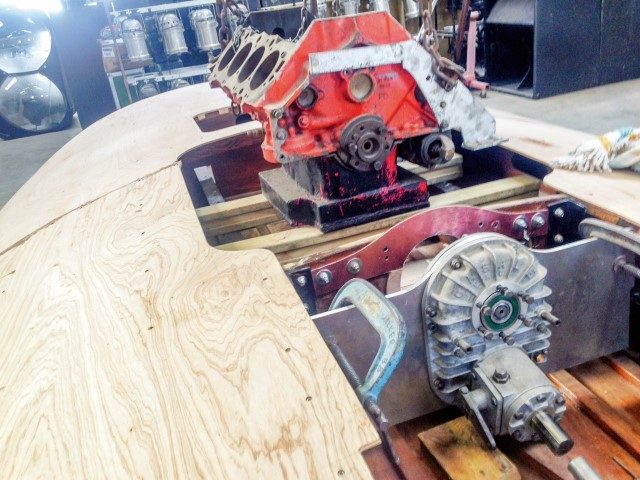

In the late 60s Elray III – New Zealand’s fastest hydroplane of the period – carried a number of drivers across the elusive 100mph threshold. But for two enthusiasts, this historic racer might have rotted into obscurity. Story by Lawrence Schaffler.
Classic restorations are always interesting projects – partly because they demand skills from a bygone era, and partly because they almost always uncover intriguing bits of information that would have been lost to history.
Elray III – built in 1967 – is a prime example. Missing in action for many years, she returned to the public eye at the NZ Antique and Classic Boat Show down at Lake Rotoiti earlier this year – an immaculate resurrection that went on to secure the event’s Best Restoration Award.

But behind her polished presentation lies a long, fascinating story about her racing years. One that involves self-taught designer-and-builder Ian Jarvie – and Jock Appleton, one of the country’s foremost powerboat racers of the time.
As the name suggest, the hydroplane is the last in a trio of vessels designed and built by Ian Jarvie. Elray I and Elray II were smaller (18’6” LOA) and powered by small block V8s. Elray III was 22’ LOA and powered by a naturally-aspirated, 427-cubic inch big block Chevy.
She carried four drivers to their Gold Badges – the certificate awarded to drivers who crossed the 100mph threshold – which in the late 60s was quite a big deal. But her life followed many twists – and to unravel them I visited Jon Jarvie, the designer/builder’s son – and also the first of the four drivers to take her across the ton benchmark.

“Dad (Ian) was a keen racer – he loved speed – with an accomplished career in his own right,” says Jarvie. “Remarkably, he was self-taught. He was a design engineer specialising in forklifts and diggers that bolted on to the back of tractors. But he had no training in naval architecture or boat design.”
The Elray boats followed after a few other of Ian’s creations, including the well-known Stingray and Hammerhead – and the ‘predator fish’ theme is prevalent throughout his naming convention.
“Dad worked closely with one of the country’s foremost powerboat racers of the day – Jock Appleton – and it was a very successful partnership. Jock was the source of the Elray name. He was always called Jock, but his initials were LRA – Louis Robson Appleton. LRA morphed into Elray.”
The Jarvies lived in Papakura and the boats were all built at home. Construction was a bit like an aircraft wing – spruce stringers with 1/8-inch mahogany plywood on the deck and ¼-inch plywood on the bottom.
All frames were punctuated with holes – like a wing structure – to reduce weight. It was all held together with brass screws and glue – thousands of screws, says Jarvie, and in those days there were no electric screwdrivers.
“I was a qualified fitter and turner and did a lot of the metal work on all three of the Elray boats. The odd thing is that the entire design was shaped by the towing legislation of the day – you couldn’t exceed 8-foot. So the beam was the starting point for Dad’s designs.”
THE ENGINE
While the first two Elrays were powered by small block engines, the bigger sister opted for a big block (427-cubic inch/seven-litre) V8.
“Sourcing hydroplane engines wasn’t easy in New Zealand in the late 60s,” says Jarvie, “because of the draconian import restrictions. But Jock was a canny chap and worked out a way to get around the issue. “He was a bridge builder and applied to import the engines and parts from the US to power his ‘crash boat’. He said he needed the crash boat to pick up his crews if they fell off the bridge into the river. A little far-fetched – but it worked!”

Elray III’s V8 was heavily modified – upgrades included high-lifting camshafts, a balanced crankshaft and high-performance pistons. It’s fuel – mixed by Jock and Ian – was a blend of methanol and aviation gas. It was delivered to the engine through four Weber carburettors. Power was transferred to the prop via a Casale V-drive. At maximum revs (around 7,200) it developed some 400-450hp.
RACING ELRAY III
Jock’s major motivation for building Elray III was to take her to America and participate in the popular seven-litre class. Sadly, that never happened.
“Down at Lake Rotoiti,” says Jarvie “I drove Elray III to 117mph – and qualified for my Gold Badge. And Jock was getting a bit of stick because I went faster than him. So that night I was instructed to change the ratios in the gearbox as well as the jets in the Webers. He went out the next day and did 124mph – but blew the engine to pieces in the process.
“We couldn’t get another engine in time – so the American campaign folded. Instead, we took her to Australia to participate in the Griffiths Cup – and we didn’t feature. But in March 1967 I did drive her to victory in Australia’s Presidents Championship.”
While the Australian events were mildly successful, the experience did provide one major development. “Many of the Australian boats were running blowers – there weren’t any in New Zealand. So when we got home we fitted a blower. Unlike modern hydroplanes, Elray III’s engine was mounted forward of the driver. Today the engines are usually at the back of the boat.

“And while the blower normally sits on top of the engine, Jock didn’t want that because he wouldn’t be able to see where he was going. So we mounted it in front of engine – and that required a helluva lot of engineering.”
Jarvie was the designated driver for the super-charged trial run – held at Papakura’s Bottletop Bay, a popular racing venue in those days.
“She went really well and I knew there was plenty of potential. But unbeknownst to me, Jock and my dad had different ideas after seeing the boat in action. By that stage I had married Jock’s daughter Judy – and Jock said the engine developed too much power and told my father he didn’t want his daughter to become a widow.

“After that one practice run they decided to sell her – much to my disappointment and disgust. I loved that boat. Elray III went to the South Island and I never saw her again. Until nearly 50 years later – at this year’s Antique and Classic Boat Show. And what a magnificent job her owners and restorers have done.”
THE RESTORATION
Elray III’s owners – based in Nelson – are Peter Rainey and Glenn Common. They’ve provided this overview of her life after Jarvie’s brief test run.
Jock sold her to Murchison’s Bill McCaa in 1971. He renamed the boat Ajay III and ran her in the original configuration. In the mid-70s Nelson’s Jack Shuttleworth bought the boat and renamed her Citation.
In the early 80s he changed the boat to a cabover/picklefork configuration – with a cavity in the bow – and moved the engine to the back. Jack campaigned the boat successfully and subsequently sold her to Hokitika’s Peter Jones. He raced the boat until 2004.

Rainey and Common purchased the boat from Jones in 2011 and brought her to Brightwater (near Nelson) where the restoration began. Over the next seven years boatbuilder Richard Walker rebuilt the hull’s front end, returning it to the original configuration. Peter Stilwell installed new stringers to the original frames, as well as a new ply bottom and deck.
A 1969 Chevelle 427 Chevrolet engine was purchased and delivered to Spike Lauria for reconditioning and commissioning, and Donald Walker installed a Casale gear box. After extensive prep and paint work – using the original colours – Elray III was reassembled and presented at the 2018 NZ Antique and Classic Boat Show – to great acclaim.

“I was hugely impressed,” says Jarvie. “She looked like she did the day she was first launched. It certainly brought the memories flooding back.”




